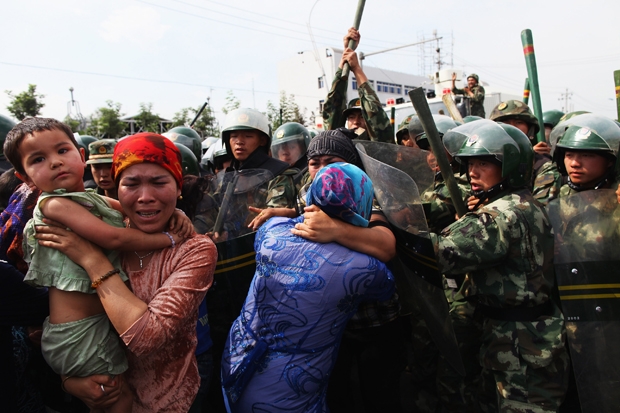In October 2013, a jeep ploughed through a crowd of pedestrians on the edge of Tiananmen Square, crashed and burst into flames, killing five people. The authorities identified the driver as Uighur, a member of an Islamic ethnic minority hailing from China’s northwest region of Xinjiang. Six months later, eight knife-wielding Uighurs rampaged through a packed railway station in Kunming in southwest China, killing 29 people and wounding more than 140 others — an attack described by the national media as ‘China’s 9/11’.
Beijing blamed both attacks on radical Islamist organisations pursuing what it calls the ‘three evils’: terrorism, separatism and religious extremism. It claims terrorists are attempting to create an independent Islamic state in Xinjiang, directed by hostile foreign forces aligned with al-Qaeda and the Taleban. Since the World Trade Center attacks in New York in 2001, Beijing has explicitly linked its crackdown in Xinjiang to the US’s global war on terror, portraying China as a fellow ‘victim of international terrorism’. And it has used this to justify restrictions on Uighur culture and religion in the name of ‘security’.
In China’s Forgotten People, the Edinburgh-based writer Nick Holdstock sets out to ‘reveal truth from facts’ in Xinjiang, to appropriate one of the Communist Party’s pet phrases. Holdstock’s central contention is that there is little proof of either organised Islamic terrorism or widespread separatist agitation in Xinjiang, where he used to live. Instead, the spiralling violence witnessed over the past few years is itself a reaction to repressive government policies put in place to control ‘terrorism’ — a self-fulfilling prophecy that is, tragically, now inciting the real thing.
Holdstock starts with a concise history of Xinjiang, explaining how this vast expanse of desert, steppe and mountain in central Asia is actually a relatively new addition to the Chinese empire. Conquered by the Qing emperor Qianlong in the mid-18th century, it was not named ‘Xinjiang’ — ‘new territory’ in Chinese — until 1884. Foreigners referred exotically to ‘East Turkestan’, a name that would be revived by Uighur nationalists in the 1930s. No one viewed Xinjiang as an essential part of China until the 19th century, and it wasn’t until 1959 that Communist officials formulated the rigid line that Xinjiang ‘has since ancient times been an inseparable part of the motherland’.
Since then China’s leaders have encouraged Han Chinese to migrate to Xinjiang Uighur Autonomous Region, as it is now formally but misleadingly known. They have funnelled vast sums into updating the transport network, industrialising agriculture and developing the oil and gas industries. But most of this wealth has flowed back to Beijing or into the pockets of Han Chinese immigrants, fuelling resentment among native Uighurs. Conflict has surged since vicious ethnic riots in 2009 killed 197 people and injured nearly 2,000. Last year’s reported body count — though no one knows the true figure — was around 400. Beijing’s response is to enforce ‘unity and stability’ with a heavy hand.
Holdstock explains the sad plight of Xinjiang’s Uighurs, recounting how the authorities have turned much of the region into a police state, raiding homes and banning symbols of religious devotion. But he is admirably even-handed, criticising Uighur activists for distorting history for political ends. He writes scathingly of the World Uighur Congress, a US-based activist group, which perpetuates ‘the same kind of misrepresentation as the government they oppose’. This meticulously researched book is anything but a crude exercise in China-bashing.
He also chastises foreign media for too readily linking unrest in Xinjiang to separatism or terrorism. Hundreds of protests happen across China every day, and most are not politically motivated. Why should Xinjiang be any different? Reporters have done a valiant job in raising awareness of Chinese state repression in Xinjiang, but they must beware unwittingly legitimising the government’s ‘terrorist’ narrative. References to the role of the East Turkestan Islamic Movement (ETIM) — a shadowy organisation that Beijing dubiously accuses of masterminding terrorist attacks from abroad — only help the government’s cause.
So what to make of the Kunming knife attack, ‘China’s 9/11’? Holdstock admits that a small group of Uighurs deliberately targeted civilians for political ends. As such, it qualified as terrorism. But there is still no evidence that the ETIM or any other ‘terrorist’ organisation was responsible, or that the attack was fuelled by religious sentiment. An alternative explanation, he suggests, is that this was a desperate act of Uighur resistance against state repression. Since Beijing’s policy of control is supposed to ensure security, its attempt to fight ‘terrorism’ appears to be creating the very problem it is supposed to combat. And that should worry China’s leaders far more than an exaggerated threat from Islamist terrorists outside its borders.






Comments